The Ultimate Guide to EcoFlow Solar Panel Specs
- Short Circuit Current and Open Circuit Voltage
- Connector Type
- Efficiency
- Cell Type
- Rated Power
- Maximum Operating Voltage and Current
- Temperature Coefficient of Rated Power
- Temperature Coefficient of Open Circuit Voltage
- Temperature Coefficient of Short Circuit Current
- Maximum Fuse Current
- Maximum System Voltage
- Dimension (inch)
- Net Weight (kg)
- Final Thoughts
Looking to embrace sustainability and power your home with solar energy?
There’s no greater freedom than breaking away from aging infrastructure and achieving energy independence. Solar panels make that possible!
Whether you want to transition fully to solar, power your gear on an off-grid adventure, or simply reduce your reliance on the grid, solar panels are a game-changer.
With the right panels and essential components, you can harness renewable energy anywhere—at home, in your RV, or even in a tent.
Here are just a few of the benefits of solar power:
Reduced electricity bills (or none whatsoever!)
Smaller carbon footprint
Unlimited access to clean, renewable energy wherever the sun shines
Choosing the right solar panels for you requires determining numerous factors.
Making the right purchase decision can quickly become overwhelming if your eyes glaze over every time you try to decipher solar panel specs.
To help you in this endeavor, we’ve compiled this handy guide to break down each of EcoFlow’s solar panel specs — and the concepts behind them — one at a time.
We’ll refer to EcoFlow’s 400W Rigid Solar Panel as an example — the most powerful mountable option EcoFlow offers.
Short Circuit Current and Open Circuit Voltage
Short Circuit Current refers to the current flowing through both ends of the solar cell when the solar panel’s output is short-circuited, which is also the maximum current of the solar panel.
Open Circuit Voltage refers to the output voltage value of the solar cell when the solar panel is open at both ends, and it is also the maximum voltage of the solar panel.
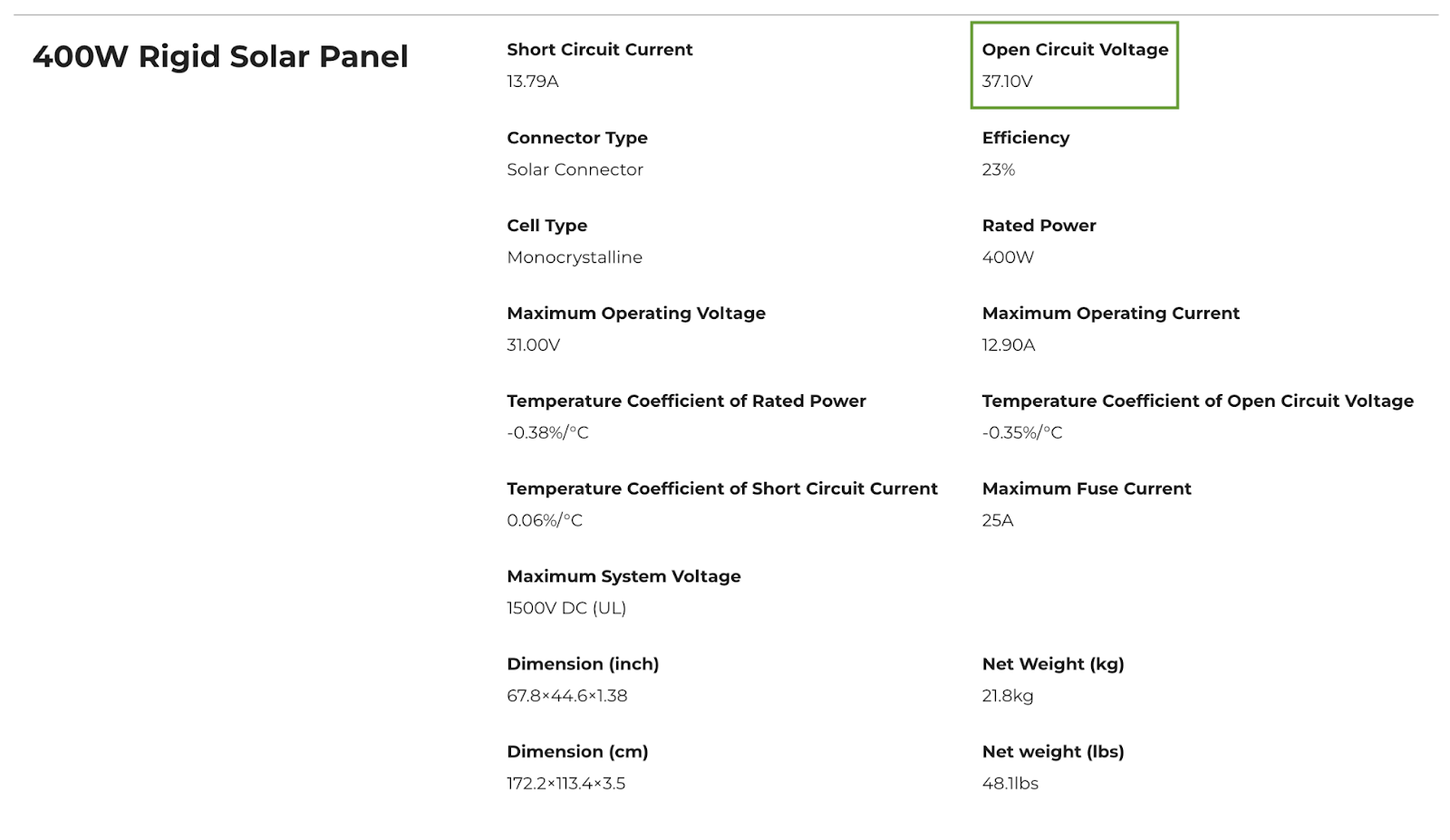

Connector Type
Connector Type refers to the type of connector used. Solar panel connectors establish a reliable and secure connection between solar panels and other PV system components, including charge controllers, inverters, and solar batteries (plug-and-play with a portable power station).
The most common type of solar panel connector is the industry standard “Multi-Contact, 4mm” (referencing the 4mm diameter of the connector’s contact pin). EcoFlow universal solar connector is compatible with this standard.
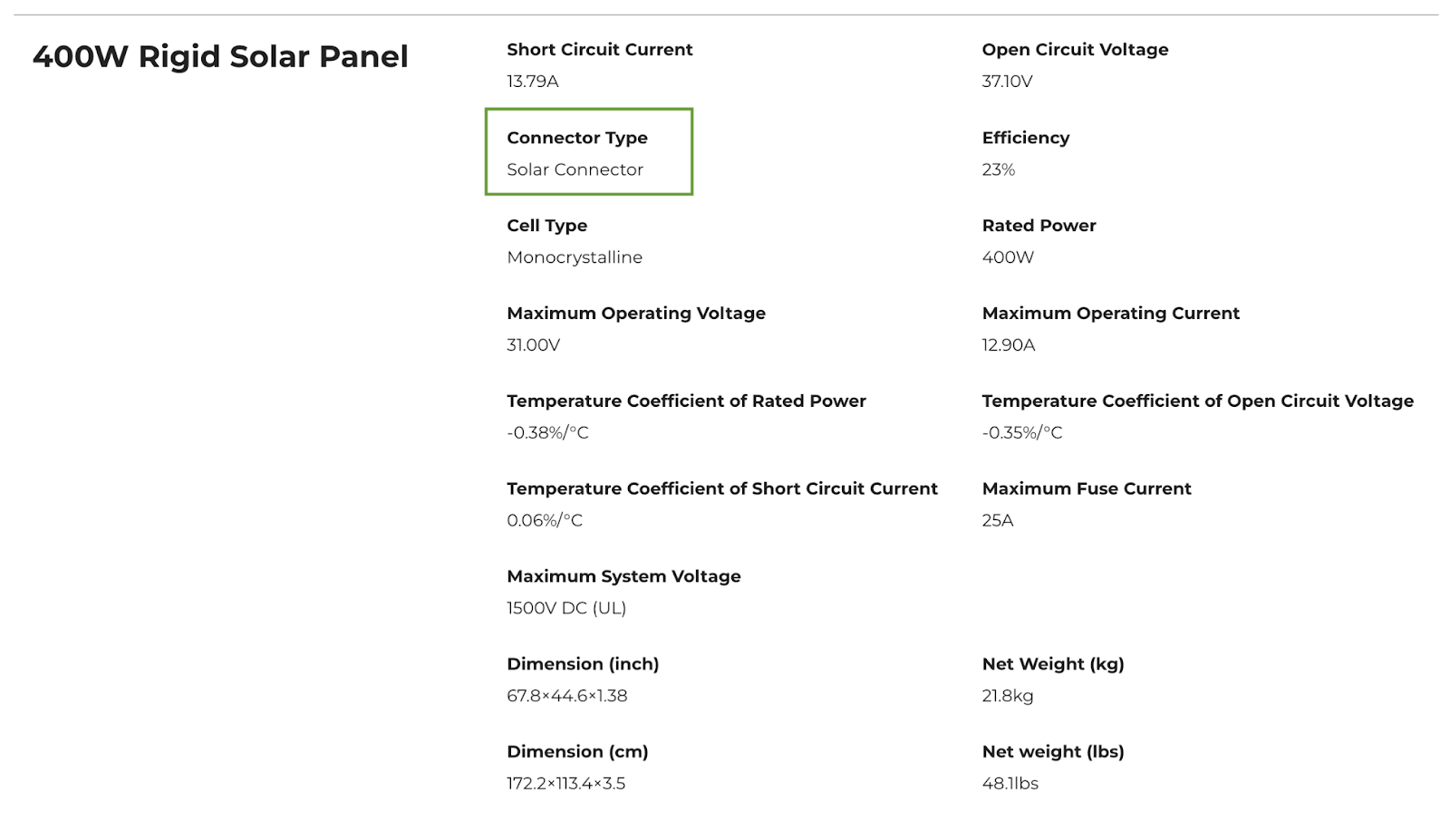

Efficiency
Efficiency measures how much electricity your panels can produce using direct sunlight. The higher your efficiency rating, the more electricity your panels generate.
This metric provides a percentage of how much of the captured sunlight your panels will be able to convert into usable energy. Generally, modern solar panels offer efficiency between 21-25% depending on the photovoltaic materials used.
While no panel will always offer maximum efficiency, EcoFlow’s monocrystalline silicon rigid, portable, and flexible solar panels boast ~23% efficiency — an industry best for this class of PV cells.
Because conditions are rarely perfect, many factors can impact the amount of electricity your panels produce. The greater the efficiency, the more you can take advantage of the available conditions.
Want to learn more? Read up on portable solar panel efficiency here.
Cell Type
Cell Type indicates the type of cells used in the solar panel. Cell types include monocrystalline, polycrystalline, and thin film solar panel types.
All of EcoFlow’s solar panels all monocrystalline silicon, including the 400W Rigid Solar Panel described here.
Do you know the signature black appearance many solar panels have? That comes from monocrystalline solar cells, the industry’s most efficient type of solar panel.
You probably know that mono means one, and poly means many. Monocrystalline solar panels have a single lab-grown silicon crystal per photovoltaic cell. A rigid solar panel typically comprises up to 200 solar cells protected by tempered glass.
By contrast, the solar cells in polycrystalline solar panels are made of — you guessed it — many silicon crystals melted together. As a result, the final product takes up more space and isn’t nearly as efficient. Polycrystalline solar panels are cheaper to manufacture, but choosing them over mono may increase your solar payback period.
Monocrystalline solar panels offer more efficiency per square meter than polycrystalline or thin film panels (where efficiency dips into the single digits).
Monocrystalline is the way to go if you want to make the most of your available space that receives direct sunlight.
Not only that, butmonocrystalline cells outperform polycrystalline cellsin hotter environments and areas without optimal sunlight, like shady places.
Monocrystalline PV panels are more expensive but provide the best efficiency ratings and a longer life span.
In short, they provide more electricity, using less space, for longer!
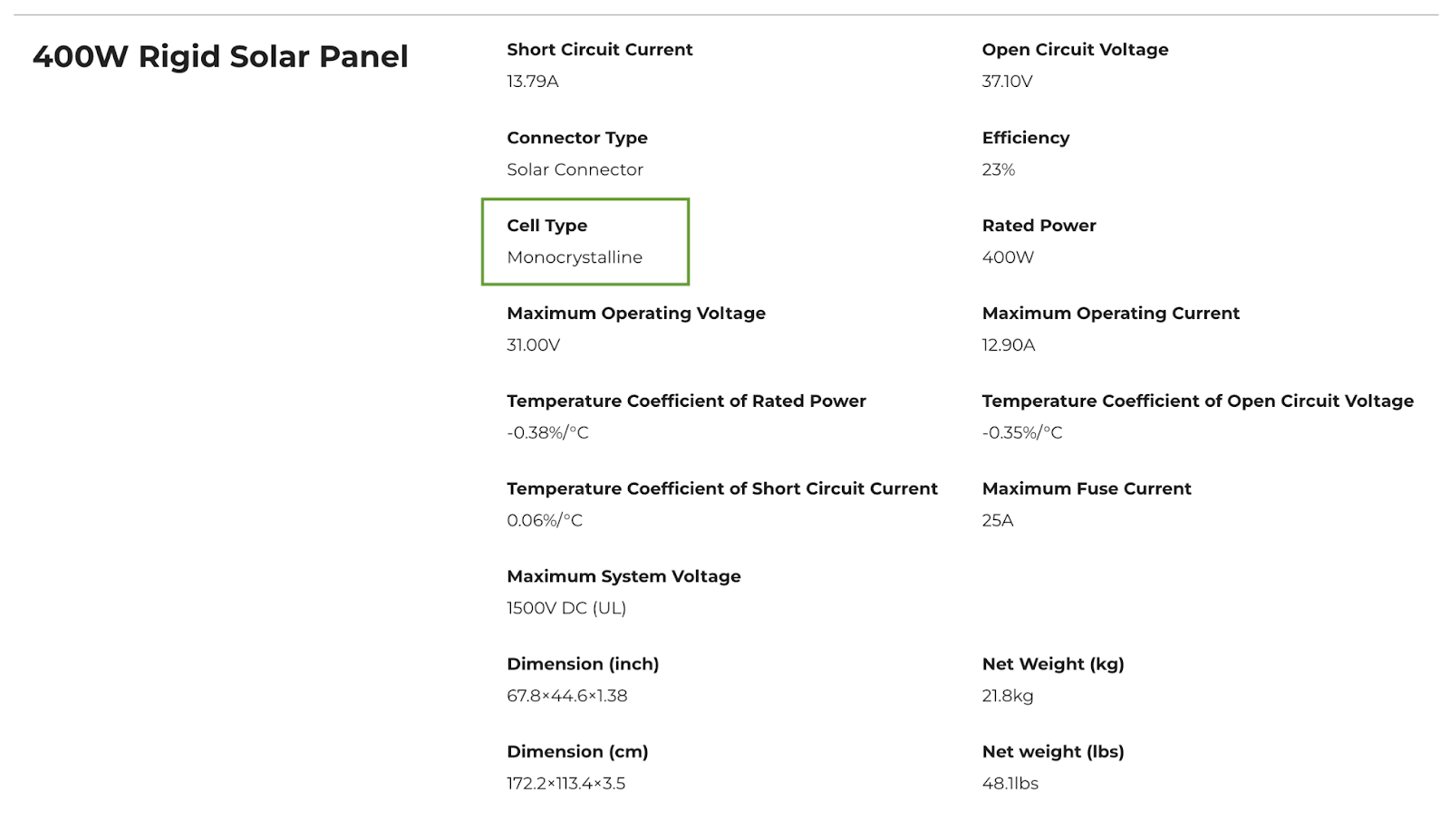

Rated Power
Rated Power measures the maximum amount of electricity a solar panel can produce. EcoFlow’s PV panel options range from 60W all the way up to 400W.
However, it’s important to note that asolar panel rarely reaches its full potential for electricity generation.
Rated power is determined in a laboratory under Standard Test Conditions. It indicates the maximum amount of electricity a solar panel can produce under ideal circumstances, including:
An optimal operating temperature of 25°C (77°F)
Full solar noon sunshine (irradiance) of 1000 W/m2 (1 kW/m2)
(Basically, the irradiance used for testing is the equivalent of direct sunlight at the brightest time of day, completely free of obstructions like clouds or shade.)Sea level air mass(AM) of 1.5 (1 sun)
Unsurprisingly, these conditions rarely exist in the real world. Understanding rated power is crucial to ensuring a solar panel array meets your electricity consumption needs.
Solar panels can produce up to (but never exceed) their rated power. In real-world applications, the output will depend significantly on outside temperature, how much direct sunlight your panels receive, efficiency, and more.
While it’s an inexact metric of how much electricity your panels will actually produce, it’s beneficial in ascertaining which panels (and how many) you’ll need to achieve your goals.
If you are operating your panels in tandem with a portable power station, remember that the combined rated power of any panels you plan to connect to your PPS should not exceed the solar charging input of the device.
For example, the EcoFlow DELTA Pro’s solar charging input is 1600W (and can be increased to 3200W if you chain two EcoFlow DELTA Pros together with the Double Voltage Hub).
Exceeding the solar charging output of your portable power station (or any battery in which you plan to store electricity generated by your panels) will not produce more electricity. In fact, it may damage your portable power station or battery.
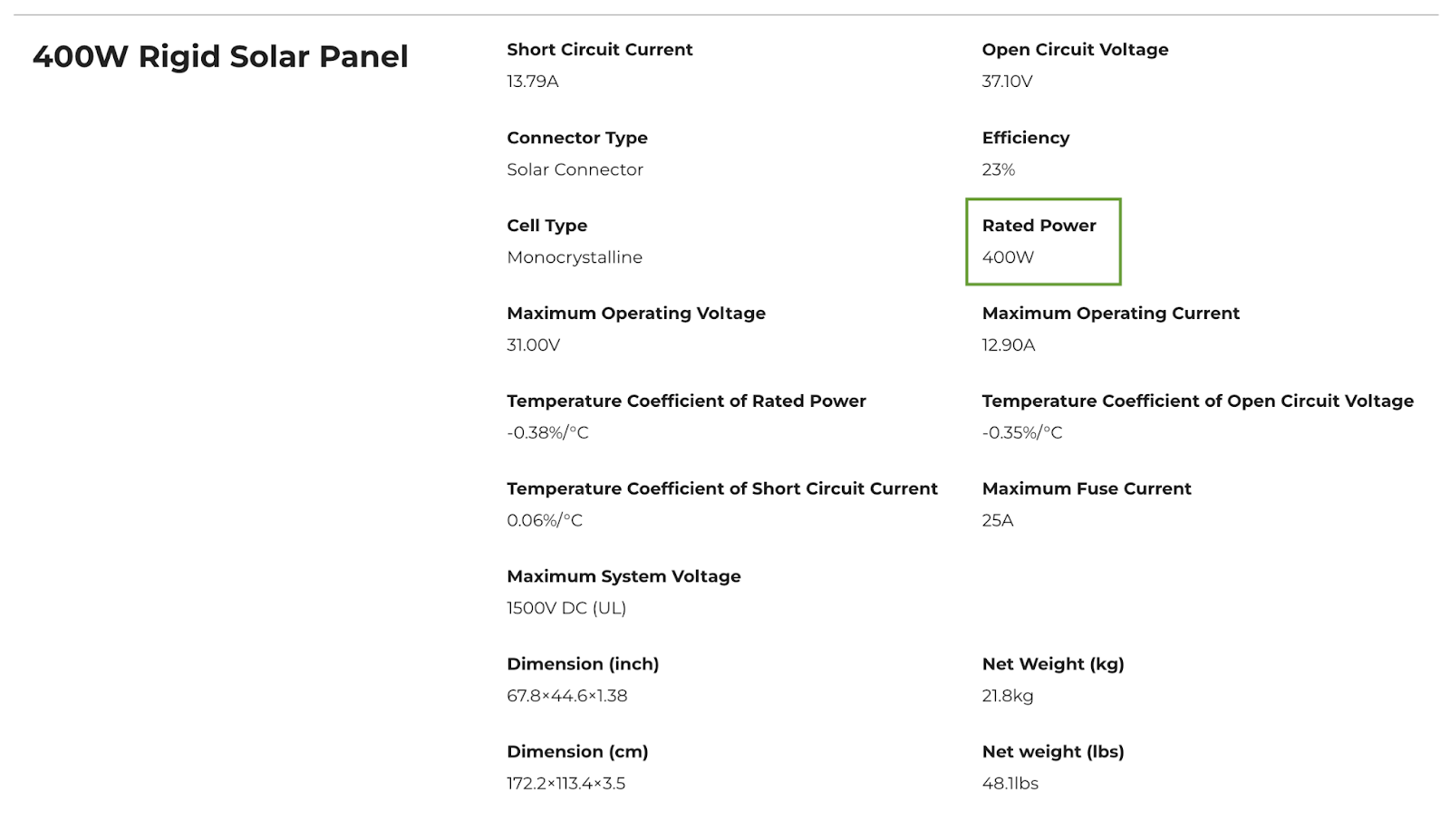

Maximum Operating Voltage and Current
Maximum Operating Voltage indicates the maximum voltage a PV panel can produce.
Maximum Operating Current indicates the maximum amperage the solar panel can produce.
Temperature Coefficient of Rated Power
Temperature Coefficient indicates that the general standard for measuring the rated power output of photovoltaic panels is based on 25 °C calibration. In actual use, the ambient temperature will vary widely. The efficiency of solar panels will change with changes in temperature. The temperature coefficient indicates the proportion of flux.
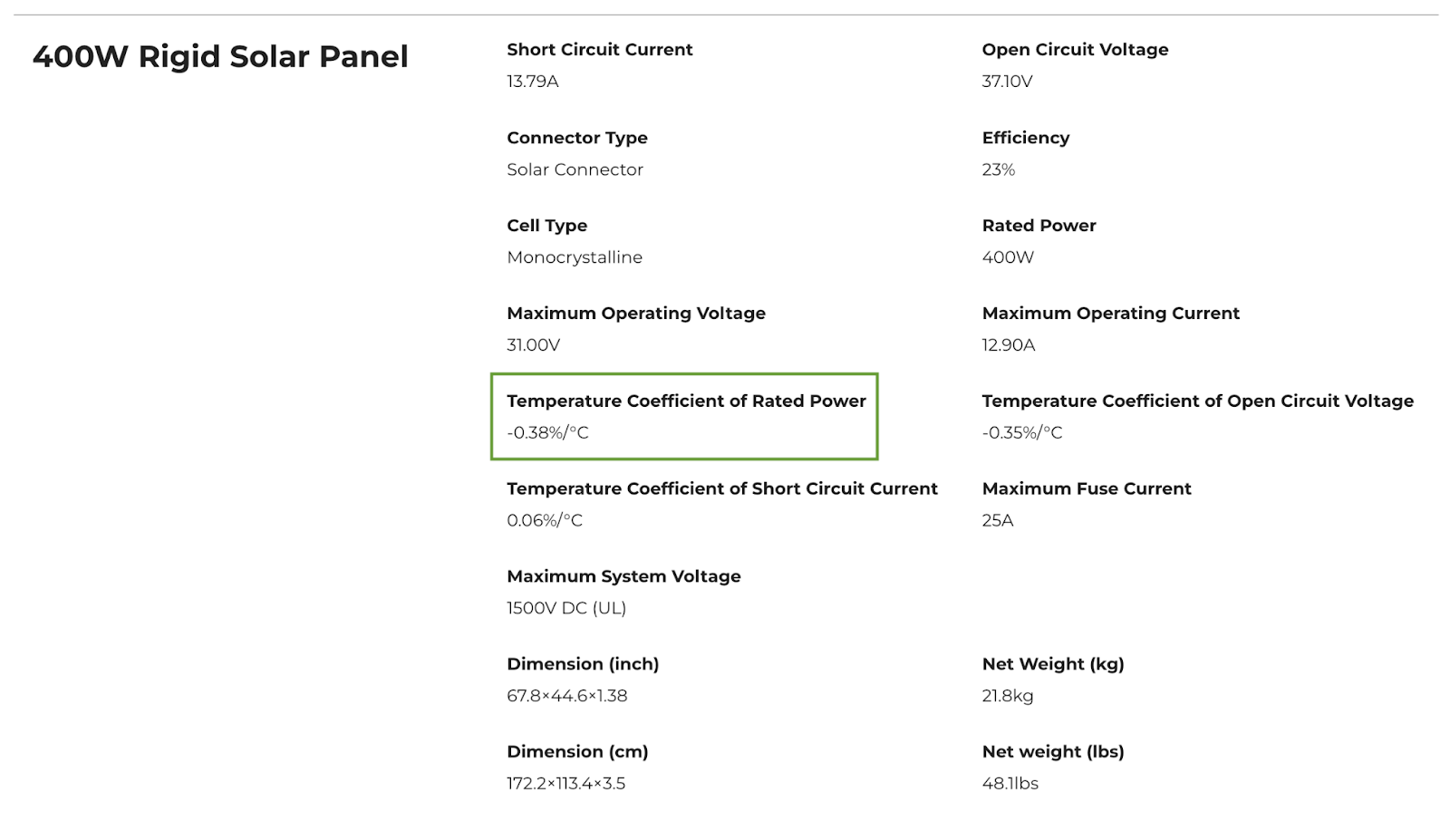

Temperature Coefficient of Open Circuit Voltage
Temperature Coefficient of Open Circuit Voltage indicates how much a solar cell’s current, output voltage, or power changes due to the ambient temperature surrounding the cell (before the array has started warming up).
Several factors can impact the performance of your solar panel, including the type of panel you have, the amount of solar irradiance, the age of your panel, and more.
The temperature coefficient of open circuit voltage is one of these factors.
It’s measured by the ratio of the change in electrical performance when the temperature of your array is increased or decreased by multiples of 1°C relative to the 25° temperature from Standard Test Conditions.
With the -0.35%/°C temperature coefficient of open circuit voltage offered by the EcoFLow 400W Rigid Solar Panel, this means that for each 1°C change in temperature, the voltage, power output, or current of your solar panel will change by 0.35%.
If the temperature is above 25°C, that much voltage is temporarily lost. To contrast, if it’s under 25°C, that much voltage is temporarily gained.


Temperature Coefficient of Short Circuit Current
Temperature Coefficient of Short Circuit Voltage indicates the same parameters as open circuit voltage, except in this case, the coefficient is 0.06% °C.
Maximum Fuse Current
Maximum Fuse Current indicates the amount of amperage the panels and system are protected from.
The fuse functions to protect solar panels from electrical overcurrents. These can occur as a result of high temperatures or shading. When you’re designing your solar power system and selecting its components, this is an essential factor to consider to ensure it’s appropriate for the size of your panels and how many of them you will have.
Considering the maximum fuse current in the design of your solar power system helps to ensure that your system is protected from overcurrents and that it operates safely. The fuse typically can be found in the combiner box, which usually houses the electrical connections between the inverter and your solar panels.
This vital safety feature helps to protect your solar panels and your entire system.
Maximum System Voltage
Maximum System Voltage indicates the maximum voltage your solar panel system can have based on the panel you use. Different system voltages exist for portable energy storage. For example,EcoFlow DELTA Pro offers 150V of maximum voltage.
When you connect solar panels into “strings,” their voltages are added together. Their total voltage cannot exceed the maximum system voltage.
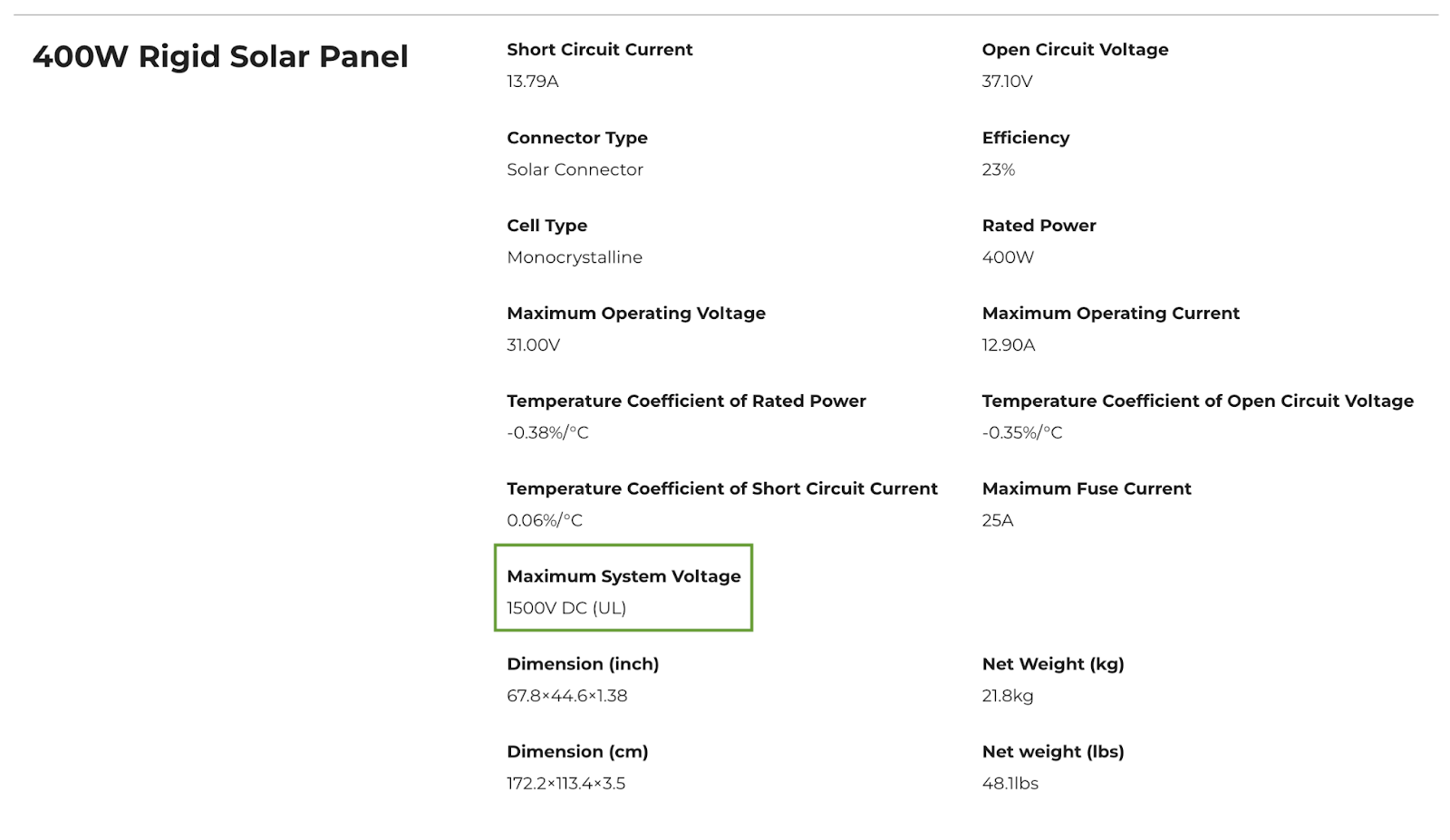

Dimension (inch)
Dimension refers to the size of the panel, measured in inches or centimeters. It is essential to ensure you have a sufficient surface area that receives direct sunlight before selecting your panels.
For residential installations, you will require multiple solar panels. To be on the safe side, choose a portable power station that leaves you room to expand, like EcoFlow’s DELTA Pro.
Flexible solar panels are an excellent option for helping you maximize the available surface area for capturing the sun’s rays.
Net Weight (kg)
Net Weight refers to the weight of a single solar panel, measured in kilograms (kg) or pounds.
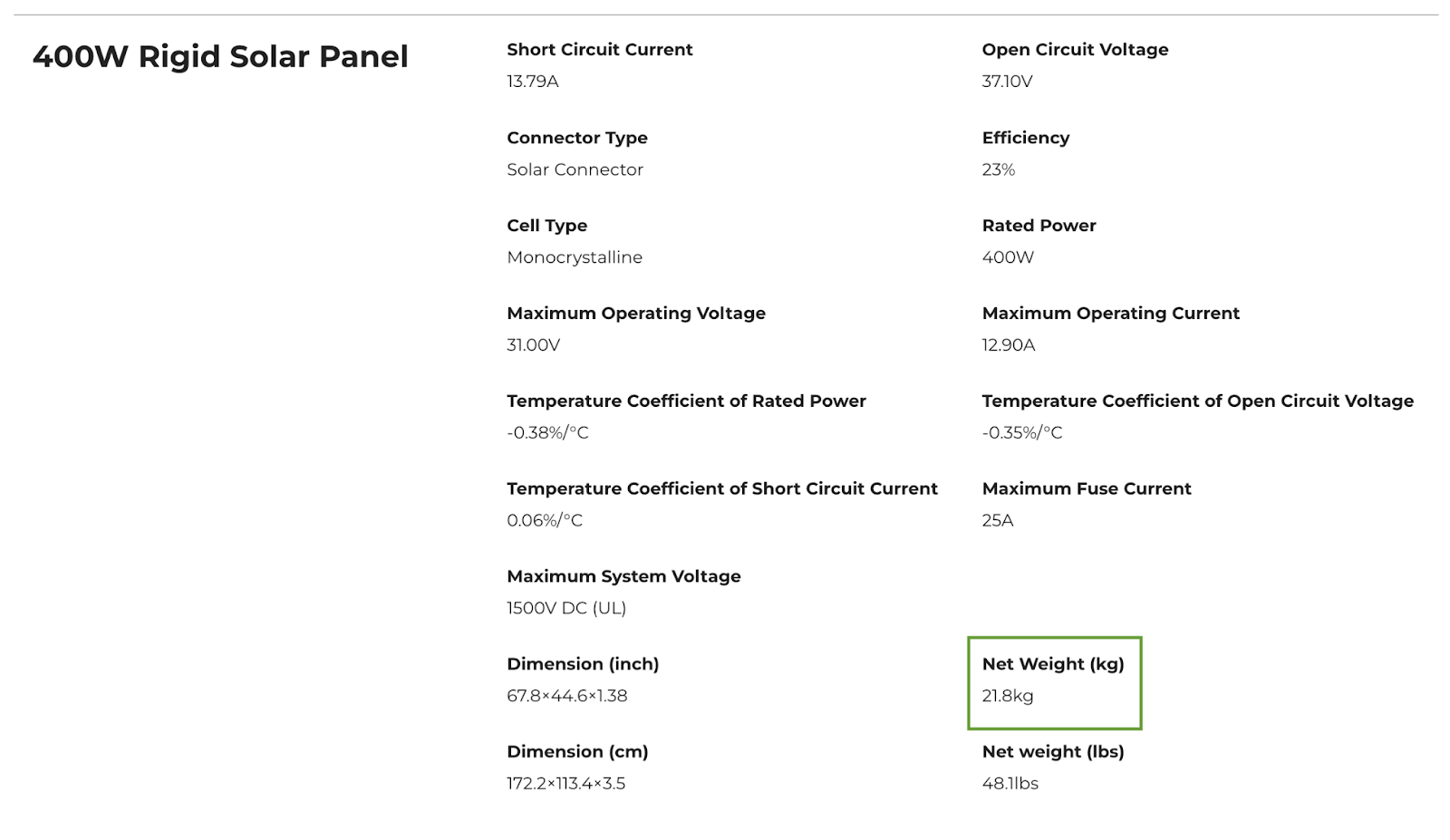

Final Thoughts
Don’t let solar panel specs overwhelm you! With a little time and attention, finding the right solar panels is easier than it seems.
Before making a purchase, there’s one crucial factor to consider—the type of panel that best suits your needs.
EcoFlow offers three main types of solar panels: rigid, flexible, and portable. Rigid solar panels are ideal for off-grid home solutions or augmenting your existing electrical system. Portable solar panels are perfect for camping trips and on-the-go power needs. Flexible solar panels offer adaptability, making them a great choice for mounting on an RV.
While we’ve used a portable solar generator as an example to explain the specs, the same principles apply across all types. Once you’ve determined what you need to power your system, you’ll be ready to make your purchase—and start enjoying greater energy independence.
Trust us—once you experience the freedom of generating your own power wherever the sun shines, you’ll never look back!